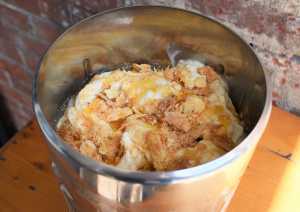Licked straight out of the cone or scooped with a spoon into eager mouths, gelato is straight-up delicious, especially in the summer months. And Toronto is home to some amazing gelato spots. However, when it comes to defining the frozen treat, things get a little confusing. While there are similarities, gelato isn’t just ice cream that comes from Italy — the dessert uses different ingredients, undergoes a different process, and has a totally unique texture compared to its North American counterpart.
Lois Kim and Carlo Diano, a graphic designer and teacher, were so curious about the frozen fraternity that they attended Carpigiani Gelato University in Bologna. Returning full of sugar and optimism, the pair left their careers to open Futura Granita + Gelato on St. Clair West and bring authentic Italian desserts to the St. Clair West hood. The couple gives us the inside scoop on what goes into gelato and how it differs from cool cousins ice cream, sorbet and the uber-Italian granita.

Gabriel Li
What is gelato?
Translating to ‘frozen’ in Italian, gelato is a frozen dessert that’s artisanal in nature. “When we were in school, there were three guiding principles to distinguishing a well made gelato,” says Kim. “Spreadability, that kind of smoothness; structure; and the intensity of flavour.” Despite sharing some similarities, the Italian dessert is distinct from its chilly counterparts — but a fascinating backstory goes some way towards explaining the differences between gelato, ice cream and other frozen treats.
When was it invented?
“Granita, this thing that we make, predates gelato,” says Diano. “It was the Moors that brought it to Sicily originally. They would use snow from the mountains and bury it underground. Then, when it was hot, they would dig it up and put syrups on it, and flavour it with other things, like honey. Slowly, milk was added. It was around the Renaissance that [gelato] became a dairy product.” While its origin story is widely debated (some believe it came from Florence, others say the first gelato was made with buffalo milk), most agree that in the beginning, gelato was expensive and only for the elite. Once machinery was developed in the early to mid 1900s, that made it easier to make, and gelato became more popular and readily available around the world.

Gabriel Li
What goes into it?
“It all starts from a base — milk, cream and a combination of sugars,” says Diano. “All gelato or ice cream has to have some kind of stabilizer — we use carob bean flour. All that does is absorb water and that’s what gives you the structure.” Next up, comes the flavour, which is where things can get a little complicated: “There's always a compensation. You have to balance. If you're making pistachio, you make your pistachio paste. Then you have to add a little bit of sugar to counteract the fat from the pistachio. There's always a balance between either fats, sugar and solids, or water, sugar and solids if you're making, let's say, a fruit-based gelato.”
How is it made?
“You combine all of those ingredients in your blender and let the blender do its work,” says Diano. “And then you put it in your gelato machine. There's a beater inside that's spinning and that’s why you get a smooth texture. The machine is freezing very quickly, and it's keeping the product in motion, so you don't get those large ice crystals. Eventually, during the freezing process in the machine, it incorporates air. And that's what also contributes to that sort of smoothness — that spreadability.”

Megan Virkar
What is the difference between ice cream and gelato?
While ice cream and gelato essentially use the same ingredients — dairy, sugar and air — the main difference lies in the proportions. “Ice cream has a higher percentage of fat and sugar, and also more air,” explains Kim. Ice cream often uses egg yolks, which gelato rarely does. Gelato also uses more milk, whereas (as the name suggests) ice cream has a heavier cream content. Temperature is another differentiator: “Ice cream is kept at a much colder temperature than gelato. Your tastebuds are going to be less sensitive: When you're eating something that cool, it's harder to taste. So that's why they have to add more sugar.” Gelato, on the other hand is warmer on the palate, has less air, and is denser and smoother. “When we look at pictures of gelato, we want to see a product that kind of looks like it’s in motion.”

Gabriel Li
What about the other kinds?
Granita
Granita is a semi-frozen Sicilian dessert that is neither ice nor liquid — and shouldn't be confused with shaved ice. Made from sugar, water and pure fruit or infusions, the main difference is the freezing process, which is slower and more stop-start. Less air is incorporated than its cousins. “It’s best in a hot climate,” says Kim.
Sorbetto
Another word for sorbet, sorbetto is essentially a water-based gelato. Similar to granita, it does not use dairy — just fruit, sugar and water. Sorbet has a smooth, creamy and scoopable texture.
What are some classic flavours?
“Because our shop is rooted in Italian tradition, we always have the classic Italian flavours here,” says Kim “Pistachio-hazelnut; fior di latte, which is sweet cream; the stracciatella, which is the sweet cream that has little bits of chocolate. We rotate out the other flavours, which can range from chocolate-chip cookie and fudge to apple pie — the kind of junky, North American inspired flavours. But the classic Italian flavours always remain from week to week.”

Gabriel Li
Where do you source your ingredients?
“When it comes to pistachio, we get it directly from Sicily,” says Diano. The couple is so committed to using the best Italian flavours, they even took a field trip to source authentic nuts from a small Northern Italian farm with a Protected Designation of Origin. “For the fruit, we really like to stay local,” says Kim. “We get our fruit from the Niagara region or anywhere near us.” There may be the occasional fruit flavour in March, but for the most part, Futura is committed to seasonality. “We had to go into our deep freezer and dig out some blast-frozen local peaches. But otherwise, we really like to try to serve the fruits of each season.”

Brennan Caverhill
How should it be served?
“You know how Italians are with their food: Everything is a spectacle, it’s like going to the circus,” says Diano. While Futura does serve gelato by the pint, they advise customers that it’s better enjoyed fresh out of the cabinet at the right temperature, ideally in a social setting with family or friends. “Gelato almost has that existential quality. Enjoy it in the moment, because the moment doesn't last too long — it’s gonna melt.”
